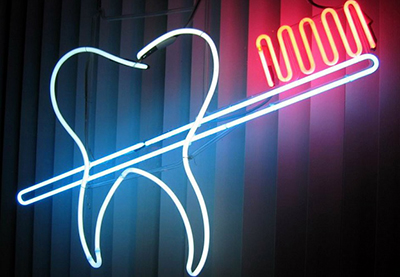Even though modern dentistry has come a long way since the days of dentists removing teeth without anaesthetic and gloves using panic-inducing, gigantic extraction ‘pliers’ that had never been sterilised on barbershop chairs, several myths circulating the field remain and even still strongly believed by certain parts of our community. Whether this stems from lack of education or mistrust from ‘Western’ medical practice, it is important to be knowledgeable and updated as delay or non-treatment of certain dental diseases that could have been prevented or treated early, could potentially be life-threatening for some of us, especially those with weakened immune system.
Myth 1: “Milk teeth are going to fall off eventually, so why treat them?”
False. Humans have two sets of
dentition; primary or milk teeth, and secondary or permanent teeth. Milk
teeth start to appear as early as 6 months of age and will naturally be
exfoliated one by one to be replaced by a new set of permanent teeth
from 6 years old. Although the milk teeth are temporary, they play
important roles in jaw development and ensure your permanent teeth erupt
in a correct position. Removing primary teeth before they’re supposed
to naturally fall off could result in their permanent successor to
appear in a haphazard way. Misaligned permanent teeth, other than being
aesthetically unpleasant, could cause difficulty in cleaning them
thoroughly. You know what happens if you don’t clean your teeth
thoroughly.
Myth 2: “When we get old, we’ll lose all our teeth as a part of natural the ageing process.”
False. This is not necessarily true, as
the longevity of your teeth has depends heavily on the good oral hygiene
practice since a young age. Common dental diseases such as tooth
cavities and gum diseases are preventable. Preventing tooth loss isn’t
that difficult either. Aside from the usual twice daily tooth brushing
with fluoridated toothpaste, flossing and limiting the frequency of
sugar intake, seeing a dentist regularly is very helpful to get early
lesion treated. Early treatment means better outlook, and better outlook
means you’re more likely to retain the pearly whites until way past
your retirement. Retaining your teeth also means the quality of life
will be maintained; you will be able to enjoy an occasional steak or
burger, at 16 or 61!
Myth 3: “If a tooth goes bad, just take it out. The filling is going to fail anyway.”
False. It is true that dental fillings
can fail, but not all fillings are doomed to fail. If a tooth filling is
done at an early stage of dental caries when the cavity is still small,
there is a higher chance that the filling can survive for a long time;
provided that you practice good oral hygiene habit and care for it like
how you care for a natural tooth. This is why regular check-up is
necessary; to detect early lesions of dental diseases and to get
immediate intervention. Bear in mind that a tooth that has been filled
can still get a new cavity if you neglect brushing and flossing.
Removing the teeth doesn’t solve anything. You may get temporary relief
from pain, but as time passes and several tooth removal later, you will
realise that eating, speaking and socialising are not as enjoyable
anymore. So you get a denture made to replace them, which doesn’t feel
quite the same. You will get used to denture discomfort sooner or later,
but it will never be able to replicate natural teeth.
Myth 4: “My teeth are yellow.”
True. Your teeth are yellow. And it is
completely natural and healthy to have slightly yellow teeth. Enamel,
the outermost layer of your teeth, is translucent. Dentine, the layer
underneath the enamel, is yellow in colour. This gives the yellowish
tint that is visible through the translucent enamel. If you have a fair
complexion, your teeth can appear more yellow due to lack of contrast
against your natural skin colour, and this is totally normal. As you
age, your enamel will be gradually worn out from years of grinding and
chewing, and become thinner, so that the dentine colour is even more
visible. However, yellow teeth can also be caused by other reasons;
smoking, pigmented beverages such as coffee and soft drinks, staining
due to poor oral hygiene and tetracycline intake during tooth
development stages. What is more important than having
Hollywood-star-like white teeth is making sure that your teeth are clean
and your breath doesn’t smell! However, if the yellowness bothers you,
there are treatments that can be undertaken to lessen it, which can be
discussed during your next dentist visit.
Myth 5: “Tooth extraction can cause eye damage.”
False again. Tooth extraction is
completely safe for the eyes and doesn’t cause short or longsightedness
or blindness. Although they may seem to be closely placed, the nerves
supplying the teeth and the eyes are different. The nerves supplying the
eyes go directly into the eyes as they emerge from the brain, while the
nerves supplying the teeth go towards your facial structures. This is
why you feel numbness in your cheek and lips after local anaesthetics
injection. You may also feel numbness of the skin below your eyes if you
get an injection for upper front tooth removal, but rest assured that
the numbness only affects the skin. Your vision and eyeball movements
remain unaffected, even if you get your ‘eye tooth’ removed.
Dr. Husna Razak (BDS) (KLE VK) is a dental officer working in the Kelantan. Know more about her in The Team page.

